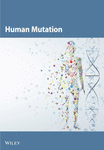The androgen receptor gene mutations database (ARDB): 2004 update†
Communicated by Alastair Brown
Abstract
The current version of the androgen receptor (AR) gene mutations database is described. The total number of reported mutations has risen from 374 to 605, and the number of AR-interacting proteins described has increased from 23 to 70, both over the past 3 years. A 3D model of the AR ligand-binding domain (AR LBD) has been added to give a better understanding of gene structure–function relationships. In addition, silent mutations have now been reported in both androgen insensitivity syndrome (AIS) and prostate cancer (CaP) cases. The database also now incorporates information on the exon 1 CAG repeat expansion disease, spinobulbar muscular atrophy (SBMA), as well as CAG repeat length variations associated with risk for female breast, uterine endometrial, colorectal, and prostate cancer, as well as for male infertility. The possible implications of somatic mutations, as opposed to germline mutations, in the development of future locus-specific mutation databases (LSDBs) is discussed. The database is available on the Internet (http://www.mcgill.ca/androgendb/). Hum Mutat 23:527–533, 2004. © 2004 Wiley-Liss, Inc.




